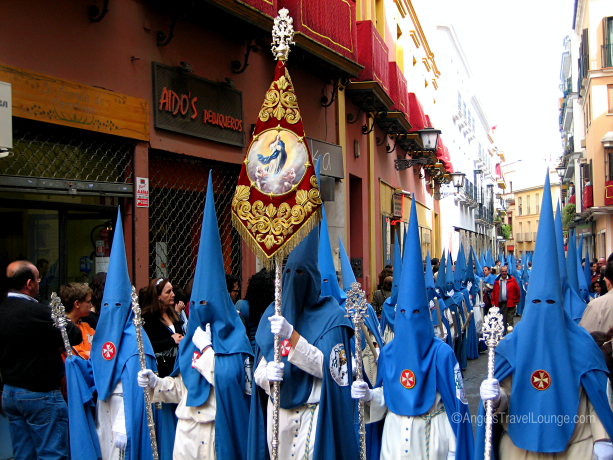Holy Week in Andalucia, Spain
 Sevilla during Holy Week will welcome you with open arms. From the Puerta de Jerez, you may notice several horse drawn buggies on their way to the Cathedral. On Palm Sunday the sound of the tolling bells from the enormous Giralda (bell tower) fill the city. A procession to the Cathedral marks the beginning of the most Holy Week in a Spaniard’s calendar. On my visit, the initial procession on Palm Sunday was led by small boys in red & white robes holding palm branches. Then they are followed by men in dark suits with gold medallions around their necks. The next segment is a gold float of the Virgin Mary. On this Palm Sunday, it was proceeded by a glorious choir belting out an anthem proclaiming the arrival of the Holy Queen. Following the choir was a series of priests and bishops culminating with the Archbishop of Sevilla in his full vestments and regalia. This procession is a great introduction to Holy Week in Andalucia, Spain.
Sevilla during Holy Week will welcome you with open arms. From the Puerta de Jerez, you may notice several horse drawn buggies on their way to the Cathedral. On Palm Sunday the sound of the tolling bells from the enormous Giralda (bell tower) fill the city. A procession to the Cathedral marks the beginning of the most Holy Week in a Spaniard’s calendar. On my visit, the initial procession on Palm Sunday was led by small boys in red & white robes holding palm branches. Then they are followed by men in dark suits with gold medallions around their necks. The next segment is a gold float of the Virgin Mary. On this Palm Sunday, it was proceeded by a glorious choir belting out an anthem proclaiming the arrival of the Holy Queen. Following the choir was a series of priests and bishops culminating with the Archbishop of Sevilla in his full vestments and regalia. This procession is a great introduction to Holy Week in Andalucia, Spain.
Holy Week
Holy Week (Semana Santa) in Sevilla is a mixture of reverence and festivity. The city buzzes with people and energy. Being in any part of Spain during the week is a great way to meet locals and experience a Spanish holiday that is steeped in tradition and pageantry. On my first day out, I passed a couple of black-hooded Nazareños on their way to the processions. It’s a bit odd to see an executioner-like figure walking down the street! The Holy Week processions are from 5pm-2:30am. After that, everyone heads to the bars. The whole town seems to be present. Hordes of people are on the street dressed in their finest. During the week, only tourists are out in the morning since the locals are still recovering from the night before. Siesta time is necessary to keep up with the late schedule of festivities and eating.

Processions
Parades or processions to the Cathedral, throughout the evening, are the highlight of the day. The first I witnessed was cavalcade of white hooded fraternal orders and richly decorated floats accompanied by marching bands. Each procession had about three floats of Jesus (from the Passion) and Mary (Regina Virgine). The candles, incense, and constant drum beat of the bands enhance the solemn scene. Once the Virgin or Jesus pass the spectators they either bow their heads or reach out their hands. The highlight is when the float stops on the corner and a man or woman comes out onto a balcony to sing. They sing sacred Andalucian song (saeta) serenading each float. The strong and passionate voice of each singer rings gloriously through the small streets and silences the crowd. Once finished, the singer is lauded with applause and shouts of “Vale!”.
Between each procession, follow the crowds to the next procession or to the local tapas bar for beer and snacks. Procession times are announced on tv and in the local newspapers, but they are hard to miss during the week.
The Nazareños (guys with pointy hats that look like executioners) dress in many colors other than white. The color and their embroidered badge, denote their particular fraternal order. Throughout the week you will see a variety of colors.
By the end of the week, the streets and cathedral floor are covered in candle wax.
The Basilica of the Macarena houses Sevilla’s most revered Virgin. The festivities in Sevilla culminate on Holy Thursday when the Virgin of the Macarena is taken from the Basilica and paraded thru the streets to the Cathedral.
Heading to smaller cities in Andalucia, like Jerez de la Frontera, is another great way to experience Holy Week. By 8:45 pm you will no doubt hear the bands begin to play. The whole town gathers in the main square. The citizens of Jerez overtake the town on evenings after daylight hours. The sounds of a saeta (sacred Andalucian song) drift throughout the narrow streets and alleys into cafes and bars. On Holy Thursday, the processions dwindle down to 3 main parades, culminating in the solemn wee hours of Good Friday (La Madruga).












